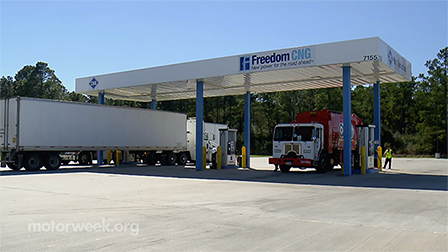Dec. 27, 2018
Gaseous Fuel Station Upgrades (Text Version)
This is a text version of the video segment Gaseous Fuel Station Upgrades, which aired on Dec. 27, 2018.
JOHN DAVIS: For many transit bus, refuse, delivery and long-haul truck fleets, making the switch from diesel or gasoline to clean gaseous fuels like CNG, propane and hydrogen the benefits are far-reaching. But stepping up to these alternative fuels also requires equipment and training to ensure that refueling and maintenance facilities can handle them safely. Well, the results speak for themselves.
The U.S. Department of Energy has teamed up with industry experts, the Gas Technology Institute and Marathon Technical Services, to address that very need. Specialized training is being offered free of charge at nearly twenty locations around the country, to educate public safety officials, fleet operators, car and truck dealers, and repair garages who want to learn more about gaseous fuels. A series of ten technical manuals and best-practices guides have been developed. But the training isn’t limited to book learning in the classroom. Site visits and tours of facilities that have already been upgraded are included so that students can gain real world practical experience.
The GRTC transit system in Richmond, Virginia, recently hosted one of these events.
CARRIE PAGE: When GRTC relocated over to this facility on Southside Richmond, it was already in the vision that there would need to be some kind of fueling location and hopefully alternative fuel. So GRTC worked collaboratively with the City of Richmond to start the process of moving toward compressed natural gas.
JOHN DAVIS: GRTC’s CNG fuel station and bus maintenance shop, like many around the country, was originally built to service diesel powered vehicles. And in order to safely handle the fleet’s conversion to CNG, the buildings needed to be retrofitted with systems to safely accommodate the gaseous fuel.
It’s important to remember that storing and dispensing gaseous fuels is safe. But personnel need to be trained to understand the differences between conventional fuels and gaseous fuels, and how to handle any leaks or other emergencies that might come up.
To begin with, gaseous fuels can’t be seen and don’t puddle on the ground like liquid fuels. So, these modern garages have electronic detectors that constantly monitor for any gas in the air and automatically set off alarms, open doors, and turn on ventilation fans if a leak is suspected.
The training also provides practical advice on how to design and operate a safe facility and teaches important gaseous fuel skill sets, like what kind of sounds or smells might indicate even tiny trace leaks, the location of emergency shut-off valves and switches, and how to calmly respond when alarms go off or other situations occur.
As more fleets, maintenance garages and car dealerships train their employees and upgrade their facilities to accommodate alternative fuels, like natural gas, propane and hydrogen, they are making it that much easier for others to follow suite. These efforts help to increase the availability of alternative fuels across the country and, also make switching to them more practical and affordable than ever before.

